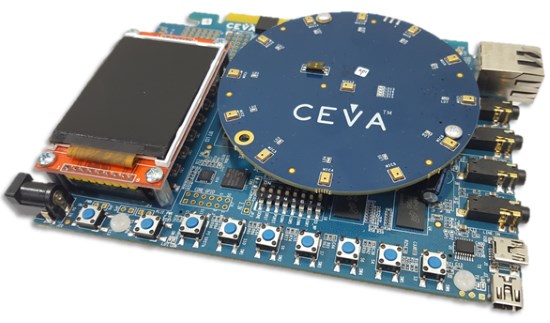Overview
The CEVA “smart and connected” development platform is the ultimate tool for algorithm and system designers who want to develop and prototype audio and sensing solutions using real-time, full-speed silicon.
The platform is built around a 500 MHz audio-and-sensing CEVA DSP chip fabricated using the IoT-centric SMIC 55 nm LP process, which also incorporates a rich integrated set of peripherals and interfaces. A multi-microphone daughter board with 13 microphones complements the high-speed silicon for development of sound‑pickup algorithms (for example, far-field voice pickup, beamforming, acoustic echo cancellation, de-reverberation and so on).

Using the included DSP RTOS, the platform provides ample processing power for multiple functions running concurrently. This enables prototyping of real-world use cases, such as always-on sensing, local intelligence, and high-throughput multi-microphone processing, all of which are supported by the “smart and connected” platform.
Because low-power signal processing is a key element in smart IoT device differentiation, the platform also provides real-time power measurement and display, which enables developers to optimize and power-tune their DSP firmware.
Benefits
The CEVA "smart and connected" development platform enables rapid prototyping and development of systems based on CEVA's audio and sensing DSPs.
Main Features
- 500 MHz CEVA audio-and-sensing DSP development chip
- DSP subsystem of integrated peripherals (TDM, DMA, I2C, I2S, ICU, Timers, GPIOs)
- Multi-microphone daughter board
- On-board dual ARM Cortex-A9 host CPU running Linux for complete CPU and DSP system prototyping
- Peripherals and interfaces, including:
- A dual on-board digital MEMS microphone
- I2C I/F for connecting sensors
- Audio CODEC with digital and analog audio in/outs
- USB, UART, PCIe, and Ethernet ports
- User-configurable FPGA, GPIOs, DDR memory, SD card, and Bluetooth dongles for wireless operation and LCD display
- Arduino connectors and drivers, which enable Arduino modules to be connected to the board, leveraging a massive ecosystem of Arduino-related products
- A wide variety of available software modules
- RTOS and DSP libraries to accelerate software development
- Multiple demos with source code included to jumpstart system design



